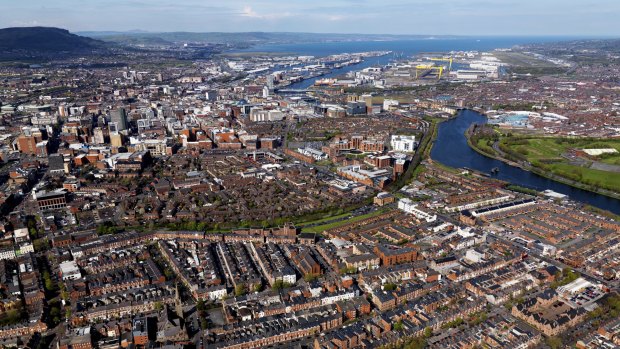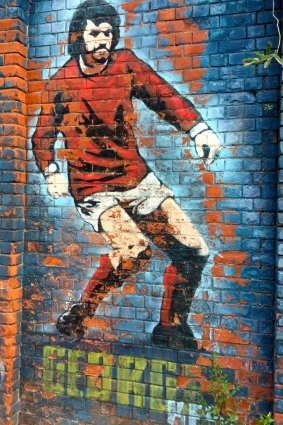This was published 8 years ago
George Best Belfast guided tour: Simply Best
By Daniel Scott

Aerial view over Belfast, Northern Ireland.Credit: Chris Hill
Whether or not you love football, the story behind the man Pele called "the greatest ever player" has many elements of Shakespearean drama.
Long before Lionel Messi donned a Barcelona shirt, before David Beckham became celebrated as much for his haircut and popstar wife as for his footballing talent, there was Belfast-born George Best. Labelled the "fifth Beatle" in the late 1960s for his brilliance, looks and charisma, Best was sport's first superstar.
All through my football-mad childhood, Georgie Best was my hero, "a player full of fantasy", according to The Times, "a player who lent magic to what might have been whimsy". For two years, in the twilight of his career, I even got to see him line up for my local team, Fulham, at their stadium, beside the River Thames.

A mural of Best in Belfast.Credit: Daniel Scott
It's also little known that Best ended his professional days in Australia, playing four games for the Brisbane Lions in the National Soccer League in 1983.
George Best would have been 70 this year. Instead, he died in 2005, afflicted by alcoholism, an illness that killed his mother, Annie.
"I was born with a great gift," Best once said, "and sometimes with that comes a destructive streak. Just as I wanted to outdo everyone when I played, I had to outdo everyone when we were out on the town."
George Best, is, with musician Van Morrison, Belfast's most famous son, and, like the singer, now has a trail in his honour. Which is why I've flown into George Best Belfast City Airport and am accompanying guide Billy Scott to where he grew up.
After establishing that Scott, like me, and an estimated 659 million fans worldwide, supports Manchester United, the club where the footballer became famous (he made 490 appearances between 1963-1974), we share a flurry of Best anecdotes.
Entering East Belfast, Scott talks warmly about the boy considered too slight and weak to play professional football by local club Glentoran, about his Protestant working-class upbringing on the Cregagh Estate.
We stop outside his childhood home, a box-like house in a row of others, on Burren Way, from where his coffin departed on December 5, 2005, en route to his funeral.
Nearby are the playing fields where he practised for hours and played for Cregagh Boys Club. Team photos show an already handsome 12-year-old, with an impish smile. His father, Dickie, coached the youngsters and his mum washed their kit and provided oranges on match days.
Best was a bright student, winning a scholarship to Grosvenor High School in West Belfast before rejecting the rugby-playing establishment and returning to Lisnasharragh School, which we visit, to pursue his love of football.
For a few hours we tour the backdrop to Best's childhood, noting the art-deco former Ambassador Cinema, on Cregagh Road, where he attended Saturday matinees. We stop outside Spence's chip shop and Desano's traditional Italian ice-cream parlour, two Belfast institutions where Best often hung out.
It wasn't long before Best's nimble feet, speed and extraordinary balance were spotted by Manchester United scout Bob Bishop.
"I think," read Bishop's telegram to United's legendary manager Matt Busby, "I've found you a genius."
At 15, he was on his way to Manchester only to come home within 24 hours with homesickness. Frailties like that make him seem all the more human a character.
"People like George Best weren't meant to grow old, sure they weren't," says Scott at Roselawn Cemetery, where a simple headstone commemorates Best and his parents.
To watch grainy footage of Best at the height of his powers – he once scored six times in a match – is to witness a joyful dance, a deft shimmying that bamboozled heavy-hoofed opponents and to see goals conjured from thin air.
Had he been born 50 years later Best would have been absurdly rich and celebrated but he ended up with little.
"I spent a lot of money on booze, birds and fast cars," he observed wryly, "the rest I just squandered."
Following the George Best trail brings into focus the humble origins of this Belfast boy, providing some answers to the question once famously posed to him by a champagne-bearing waiter at London's Savoy Hotel.
"Mr Best," he was asked, as he lay in bed with Miss World, hundreds of £5 notes in casino winnings scattered across the covers, "where did it all go wrong?"
Daniel Scott was a guest of Tourism Northern Ireland.
TRIP NOTES
MORE INFORMATION
See ireland.com
GETTING THERE
British Airways flies daily from Sydney to London Heathrow, with regular connections to Belfast. See ba.com
TOURING THERE
For details of the self-guided George Best Trail see visit-belfast.com
George Best's childhood home, at 16 Burren Way, is available for rent. See georgebesthouse.com
Sign up for the Traveller Deals newsletter
Get exclusive travel deals delivered straight to your inbox. Sign up now.